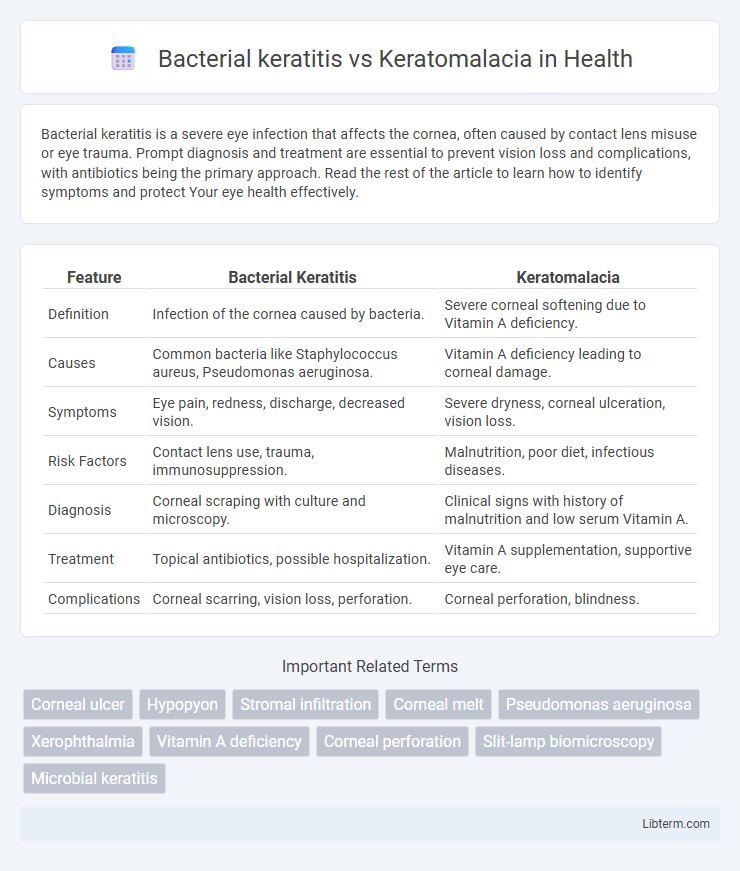Bacterial keratitis is a severe eye infection that affects the cornea, often caused by contact lens misuse or eye trauma. Prompt diagnosis and treatment are essential to prevent vision loss and complications, with antibiotics being the primary approach. Read the rest of the article to learn how to identify symptoms and protect Your eye health effectively.
Table of Comparison
| Feature | Bacterial Keratitis | Keratomalacia |
|---|---|---|
| Definition | Infection of the cornea caused by bacteria. | Severe corneal softening due to Vitamin A deficiency. |
| Causes | Common bacteria like Staphylococcus aureus, Pseudomonas aeruginosa. | Vitamin A deficiency leading to corneal damage. |
| Symptoms | Eye pain, redness, discharge, decreased vision. | Severe dryness, corneal ulceration, vision loss. |
| Risk Factors | Contact lens use, trauma, immunosuppression. | Malnutrition, poor diet, infectious diseases. |
| Diagnosis | Corneal scraping with culture and microscopy. | Clinical signs with history of malnutrition and low serum Vitamin A. |
| Treatment | Topical antibiotics, possible hospitalization. | Vitamin A supplementation, supportive eye care. |
| Complications | Corneal scarring, vision loss, perforation. | Corneal perforation, blindness. |
Introduction to Bacterial Keratitis and Keratomalacia
Bacterial keratitis is an infection of the cornea caused by pathogenic bacteria such as Pseudomonas aeruginosa and Staphylococcus aureus, leading to corneal ulceration, pain, redness, and vision impairment. Keratomalacia is a severe ocular condition caused by vitamin A deficiency, resulting in corneal softening, necrosis, and potential blindness, primarily affecting children in developing countries. Both conditions involve corneal damage but differ in etiology, with bacterial keratitis related to infectious agents and keratomalacia stemming from nutritional deficiency.
Etiology and Causative Factors
Bacterial keratitis is primarily caused by infectious bacteria such as Pseudomonas aeruginosa and Staphylococcus aureus, often associated with contact lens wear, ocular trauma, or compromised corneal epithelium. Keratomalacia, on the other hand, results from severe vitamin A deficiency leading to progressive corneal melting and necrosis, predominantly in malnourished populations. The etiology of bacterial keratitis is infectious and acute, whereas keratomalacia is nutritional and degenerative.
Pathophysiology: Mechanisms of Corneal Damage
Bacterial keratitis involves corneal damage caused by bacterial invasion and toxin production, leading to epithelial disruption, stromal infiltration, and neutrophil-mediated inflammation, which causes tissue necrosis and ulceration. Keratomalacia results from severe vitamin A deficiency, impairing mucin production and epithelial integrity, causing corneal dryness, softening, and liquefactive necrosis due to loss of cellular cohesion and proteolytic enzyme activity. Both conditions compromise corneal structure but differ fundamentally in etiology: infectious inflammation versus nutritional deficiency-induced epithelial degeneration.
Clinical Presentation and Symptoms
Bacterial keratitis typically presents with acute eye pain, redness, photophobia, and purulent discharge, often accompanied by corneal ulceration and stromal infiltrates visible on slit-lamp examination. Keratomalacia, caused by severe vitamin A deficiency, manifests as softening and necrosis of the cornea, leading to painless corneal clouding, xerophthalmia, and night blindness in the early stages. While bacterial keratitis exhibits inflammatory signs with rapid progression of corneal damage due to infectious agents, keratomalacia shows progressive corneal melting and thinning related to epithelial and stromal degeneration without initial infectious symptoms.
Risk Factors and Predisposing Conditions
Bacterial keratitis primarily affects contact lens users, individuals with ocular surface disease, or those with trauma to the eye, with risk factors including poor lens hygiene, corneal abrasion, and immunosuppression. Keratomalacia is predominantly caused by severe vitamin A deficiency, malnutrition, and conditions resulting in malabsorption, often seen in developing countries or populations with inadequate dietary intake. Both conditions compromise corneal integrity, but bacterial keratitis stems from infectious agents while keratomalacia results from nutritional deficiency.
Diagnostic Approaches and Differentiation
Bacterial keratitis diagnosis relies on corneal scraping for culture and Gram staining to identify causative pathogens, while keratomalacia is diagnosed primarily through clinical observation of corneal melting linked to severe Vitamin A deficiency, often supported by serum retinol levels. Slit-lamp examination reveals bacterial keratitis with infiltrates, stromal edema, and hypopyon, whereas keratomalacia presents with softening and liquefaction of the corneal stroma without infectious infiltrates. Differentiation hinges on microbiological culture results, nutritional assessments, and distinct clinical signs correlating with infectious versus metabolic etiologies.
Microbiological Findings and Laboratory Tests
Bacterial keratitis typically presents with culture-positive findings for common pathogens like Staphylococcus aureus, Pseudomonas aeruginosa, and Streptococcus pneumoniae, confirmed through corneal scrapings and Gram staining. Keratomalacia, caused by severe vitamin A deficiency, does not yield bacterial growth but shows characteristic epithelial cell desquamation and necrosis on histopathology, with laboratory tests indicating low serum retinol levels. Microbiological examination is crucial in distinguishing bacterial keratitis based on pathogen isolation, whereas keratomalacia diagnosis relies on biochemical assays and clinical correlation.
Treatment Strategies and Management
Bacterial keratitis requires immediate antibiotic therapy, often with broad-spectrum topical antibiotics like fluoroquinolones or fortified cephalosporins, to prevent corneal ulceration and vision loss. Keratomalacia, a severe manifestation of vitamin A deficiency, necessitates high-dose vitamin A supplementation along with supportive care, including management of secondary infections and maintaining ocular surface lubrication. Prompt treatment in bacterial keratitis focuses on microbial eradication, while keratomalacia management prioritizes nutritional rehabilitation and prevention of corneal melting.
Complications and Prognosis
Bacterial keratitis often leads to corneal scarring, stromal melting, or perforation, causing vision loss if not treated promptly. Keratomalacia, a severe vitamin A deficiency manifestation, results in corneal ulceration, liquefactive necrosis, and potential blindness with systemic complications like xerophthalmia. Prognosis for bacterial keratitis improves with early antibiotic therapy, while keratomalacia requires nutritional intervention and has a guarded prognosis, particularly in malnourished populations.
Prevention and Public Health Implications
Bacterial keratitis prevention relies on maintaining proper eye hygiene, avoiding contact lens misuse, and prompt treatment of ocular injuries to reduce infection risk. Keratomalacia prevention focuses on addressing vitamin A deficiency through nutritional programs and supplementation in vulnerable populations to prevent corneal melting and blindness. Public health strategies must integrate awareness campaigns, access to medical care, and nutritional interventions to reduce the global burden of both infectious and nutritional corneal diseases.
Bacterial keratitis Infographic

 libterm.com
libterm.com